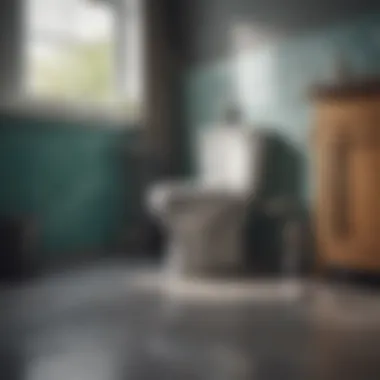Mastering Toilet Rodding: Essential Plumbing Skills


Intro
Rodding out a toilet is an essential skill for homeowners. Understanding how to remove clogs from your plumbing system can save time and money. This article delves into the tools and techniques needed for successful rodding, how to troubleshoot common issues, and the best practices for maintaining your toilet.
Issues in plumbing can disrupt daily routines. Hence, being informed on rodding procedure can empower you to handle clogs with ease. Aside from discussing the process, we also emphasize safety precautions to follow while performing rodding tasks. Regular maintenance is key to preventing future blockages and enhancing the longevity of your plumbing systems.
Why Rodding is Vital
Rodding does not just clear a blockage. It can also help with identifying the underlying issues in your toilet system. Many people face problems such as slow drainage or persistent clogs. Knowing how to rod a toilet can prevent these from escalating.
Key Points Covered in This Guide:
- Necessary tools for rodding.
- Step-by-step guide for effective rodding.
- Common toilet issues requiring rodding.
- Safety considerations.
- Regular maintenance tips to avoid future clogs.
"The ability to maintain your plumbing system greatly influences the quality of home life."
Understanding these aspects of toilet maintenance will not only provide you with confidence but can also save costly repairs in the future. Let’s explore the various topics in the upcoming sections.
Understanding the Need for Rodding Out a Toilet
Toilets are essential for everyday life, yet they are often overlooked until issues arise. Understanding the necessity of rodding out a toilet can significantly enhance your plumbing maintenance capabilities. This process can prevent more severe plumbing problems from developing, ensuring that your system runs smoothly.
Rodding out a toilet is the act of clearing blockages or clogs that occur within the toilet's plumbing. The need for this method arises when normal flushing or plunging methods fail to eliminate the obstruction. Regularly checking for blockages can help avoid problematic situations that disrupt daily routines. Knowing when and how to rod a toilet means being proactive rather than reactive.
Common Signs of a Clogged Toilet
Recognizing the early signs of a clogged toilet can save you time and hassle. Here are some indicators that indicate your toilet may be experiencing a blockage:
- Slow Draining: Water may take longer than usual to drain after flushing.
- Frequent Clogs: If you notice that you have to plunge your toilet often, this suggests a persistent issue.
- Unusual Sounds: Gurgling sounds coming from the toilet or plumbing can indicate a blockage.
- Overflowing Toilet: If water begins to overflow, immediate action is required to avoid damage.
By identifying these signs, you can take prompt action to address any potential issues before they escalate.
Consequences of Ignoring a Clogged Toilet
Ignoring a clogged toilet can lead to a variety of negative consequences that may affect both the plumbing system and your home environment. Some of these consequences include:
- Increase in Repair Costs: Minor clogs can turn into major problems requiring extensive repairs.
- Health Hazards: Standing water can lead to bacterial growth, posing a risk to you and your family's health.
- Water Damage: Overflowing toilets can cause water to seep into floors or walls, leading to mold and structural damage.
- Inconvenience: A malfunctioning toilet restricts access to one of the most used facilities in the home, affecting daily activities.
In summary, understanding the need for rodding out a toilet highlights its role in maintaining functional plumbing systems. Recognizing common signs of a clog and acknowledging the potential consequences of neglecting these issues can encourage proactive management and reduce the likelihood of severe plumbing disasters.
The Rodding Process Explained
Understanding the rodding process is crucial for homeowners who aim to maintain their plumbing systems effectively. Rodding out a toilet is not just a troubleshooting measure; it is a proactive step that can save time and money in the long run. Proper execution of this process can prevent further complications, such as water damage or extensive plumbing repairs. Knowing how to rod effectively also empowers homeowners, reducing reliance on professional help for minor issues.


Essential Tools for Rodding Out a Toilet
When undertaking the rodding process, having the right tools is essential. They directly affect the effectiveness of the procedure and the ease of tackling clogs. The main tools involved include a toilet auger, a plunger, and protective gear.
Toilet Auger
A toilet auger is specifically designed for clearing clogs in toilets. Its unique construction, featuring a flexible cable and a spiral head, allows it to navigate bends in piping without causing damage. One key characteristic is its ability to reach deep into the toilet and pipes, where blockages often lie. This makes it a popular choice for homeowners. The sturdy build of a toilet auger provides durability and longevity. However, it requires some skill to use effectively, so practice is necessary to avoid potential mishaps.
Plunger
The plunger is likely the most conventional tool employed for clearing toilet clogs. It operates by creating suction and pressure, effectively dislodging blockages. Its simplicity is a major advantage, making it accessible for homeowners of all skill levels. The unique feature of a plunger is its affordable price and easy availability. However, it may not always be effective against stubborn clogs. Therefore, if a plunger fails to resolve the issue, it is prudent to turn to more specialized tools like the toilet auger.
Protective Gear
Using protective gear is an important aspect of the rodding process. Gloves and masks should be worn to safeguard against harmful bacteria and unpleasant odors that may arise during the process. One key characteristic of protective gear is its essential role in ensuring personal safety. Wearing quality gloves, for instance, can prevent skin contact with harmful substances. While protective gear may seem like an extra step, it is a necessary precaution that should not be overlooked.
Step-by-Step Guide to Rodding Out a Toilet
Executing the rodding process involves careful steps to ensure efficiency and safety. Preparation is fundamental, as is effective use of tools during the process. This part of the guide outlines the crucial stages in the rodding process.
Preparing the Area
Preparation before initiating the rodding process cannot be neglected. Ensuring the area around the toilet is clear allows for easier maneuverability. Additionally, placing towels or newspapers on the floor can protect surfaces from potential spills. Highlighting safety and cleanliness, taking these steps diminishes the chances of further mess. Moreover, adequate lighting can help to identify issues efficiently.
Using the Auger Effectively
Using the auger effectively requires a technique that maximizes its capabilities. Start by inserting the auger into the toilet bowl, ensuring to make contact with the blockage. Gently cranking the handle allows the spiral head to expand within the pipe. This process dislodges clogs effectively. One of the primary benefits of using the auger properly is the removal of stubborn blockages without damaging the toilet or pipes. Care should be taken not to force the auger, as excessive pressure can cause injury or damage to the plumbing.
Clearing the Blockage
Once the auger has maneuvered through the blockage, the next step is clearing it completely. Pulling the auger back gently removes any debris that may have latched to it. After clearing, it is advisable to flush the toilet to check if the blockage has been resolved. This unique phase is crucial as it transitions the process from troubleshooting to successful maintenance. If problems persist, further probing with the auger may be necessary, or other methods should be considered before calling a plumber.
Key Point: Mastering the rodding out procedure integrates knowledge of tools, techniques, and safety into an efficient plumbing maintenance routine.
Safety Precautions During Rodding
Engaging in rodding out a toilet requires a careful approach to ensure safety and effectiveness. Homeowners often overlook the safety aspect, assuming that the task can be completed without consideration for personal well-being or hygiene. However, proper precautions can prevent injuries, minimize exposure to contaminants, and ensure a successful operation.
Personal Protective Equipment to Wear
When preparing to rod out a toilet, it is crucial to wear the appropriate personal protective equipment (PPE). This not only protects the individual performing the task but also maintains a clean environment. Recommended PPE includes:
- Gloves: Use durable rubber gloves to protect your hands from germs and chemicals.
- Goggles: Protective eyewear can shield your eyes from splashes of dirty water or debris.
- Mask: A mask can help filter out any unpleasant odors and protect against inhaling particles.
- Footwear: Closed-toe shoes with slip-resistant soles provide safety against slipping and falling in a potentially wet area.
Wearing the right equipment not only safeguards health but also boosts confidence when tackling plumbing issues.


Sanitizing Your Tools and Work Area
After addressing the clog, sanitation becomes vital. Ensuring that tools and working surfaces are sanitized reduces the risk of spreading bacteria and keeping the household safe. Here are some essential steps to follow:
- Clean Tools Immediately: After using tools like a toilet auger and plunger, clean them with disinfectant wipes or a bleach solution, as they may harbor bacteria from the toilet.
- Disinfect Surrounding Area: Wipe down the surfaces surrounding the toilet, including the toilet seat and the floor area, to eliminate any possible contamination.
- Proper Waste Disposal: If any physical debris or waste is removed, ensure it is placed in a sealed plastic bag before disposal to prevent any leakage.
Taking the time to sanitize not only fosters a safer environment but also contributes to the longevity of your plumbing tools. Overall, focusing on safety can transform a potentially challenging task into a manageable one. Always prioritize precautions, ensuring a hygienic and effective rodding experience.
Troubleshooting Toilet Issues
Addressing toilet issues can greatly enhance the comfort and functionality of your home. The ability to troubleshoot these problems empowers homeowners to manage plumbing issues effectively. Understanding the types and causes of clogs helps in developing appropriate strategies for resolution, potentially saving time and costs. This section covers the various types of toilet clogs and when you may need to seek professional assistance.
Identifying Different Types of Clogs
Understanding the different types of clogs is crucial for efficient troubleshooting. Homeowners must be able to differentiate between minor clogs and major blockages. This knowledge dictates the course of action, whether you attempt a simple fix or call for help.
Minor Clogs vs. Major Blockages
Minor clogs are typically easy to resolve and often require a plunger or a simple toilet auger. These clogs usually result from an accumulation of small items or waste, leading to temporary blockages. In contrast, major blockages might involve multiple fixtures and indicate larger issues in the plumbing system. Major blockages often necessitate more complex methods of removal or, at times, professional intervention.
A key characteristic of minor clogs is their accessibility to basic home tools, often allowing homeowners to regain toilet functionality within a short time. This does not mean that minor clogs should be overlooked. They can develop into more significant issues if neglected.
Minor clogs may seem insignificant, but they are often the first warning signs of problems that can escalate.
Conversely, major blockages may result from deeper pipe issues or the buildup of materials that are difficult to remove without specialized equipment. While it may be tempting to resolve this issue on your own, it is often wise to assess the severity of the blockage first.
Physical Obstructions vs. Pipe Issues
Differentiating between physical obstructions and pipe issues is essential when troubleshooting toilet troubles. Physical obstructions may consist of items such as wipes or toys stuck within the toilet trap. These can usually be resolved with a plunger or an auger. In contrast, pipe issues might involve more severe matters such as tree root intrusions or corroded pipes.
A key characteristic of physical obstructions is their visibility and often straightforward removal. However, pipe issues can be hidden, requiring inspection tools or camera services to identify the precise location of the problem. Being able to identify the type of problem informs the appropriate action to take.
Physical obstructions tend to present with recognizable symptoms like a slow drain or backflow, pointing to the possibility of a simple fix. On the other hand, pipe-related issues may require extensive evaluations and professional help to mitigate risk of further damage.
When to Call a Professional Plumber
Certain situations warrant a call to a professional plumber. If your attempted troubleshooting does not yield successful results within a timely manner, or if you notice recurring problems, professional assistance becomes invaluable. Signs like persistent drainage issues, unusual noises, or water pooling can indicate deeper issues needing expert diagnosis.
Additionally, if you have attempted fixing clogs but the problem keeps returning, it might signal structural plumbing problems in your home. In such cases, delaying professional help can lead to far more expensive plumbing repairs in the future. Recognize that some issues are complex and require advanced tools and expertise; this is when a professional plumbing service becomes essential.
Preventing Toilet Clogs: Best Practices
Preventing toilet clogs is essential for maintaining a fully functional bathroom. Regular upkeep and informed usage can greatly reduce the chances of encountering blocking issues. The significance of implementing robust practices cannot be overstated. Proper prevention not only saves time and resources but also enhances the longevity of plumbing systems. By actively adopting preventive measures, homeowners can avoid the stress of unanticipated plumbing emergencies.
Regular Maintenance Tips


Regular maintenance is the cornerstone of avoiding clogs. Simple practices can lead to significant improvements in toilet functionality. Here are some effective tips:
- Routine Inspections: Periodically check your toilet for any leaks or signs of wear. Addressing these issues early can prevent more significant problems.
- Flushing Habits: Always flush twice when necessary. This is especially important for items that may stick to the toilet bowl.
- Water Quality Checks: Hard water can lead to mineral buildup in pipes. If necessary, install a water softener to mitigate this.
Understanding Proper Toilet Use
Understanding proper toilet use can dramatically decrease the need for rodding. This knowledge empowers homeowners to be mindful. Proper usage ensures that waste disposal does not lead to blockages.
Disposing of Waste Properly
Disposing of waste properly is crucial. Many people overlook this aspect, thinking all waste can be flushed. This is not correct. Only human waste and toilet paper should go down the toilet. Commonly made mistakes include flushing:
- Paper towels
- Female hygiene products
- Wipes (even those labeled as flushable)
By limiting what is disposed of in the toilet, homeowners can avoid frequent backups, giving the plumbing a longer life. This practice is cost-effective and stress-free for any homeowner.
Avoiding Non-Flushable Items
Avoiding non-flushable items is another significant point. Many daily items seem suitable for flushing but are not. These can create blockages. Avoid:
- Non-flushable wipes
- Food waste
- Excessive toilet paper
Understanding why avoiding these items matters is promintent. Such items do not break down easily in water. Consequently, they contribute to derious obstructions. By remaining disciplined utilizing the toilet, blockages can be significantly decreased.
"Proper use and maintenance of a toilet can save time and avoid unnecessary expenses in plumbing repairs."
Incorporating these practices can lead to peace of mind for homeowners. It creates a robust system against potential issues. By preventing clogs, homeowners can enjoy the longevity of their bathrooms.
Finale: Mastering the Art of Toilet Rodding
Rodding out a toilet is a key skill that every homeowner should understand. This article provides an in-depth look at the intricacies of this process, highlighting the critical elements of tools, techniques, and maintenance. By being informed about the rodding process, homeowners can effectively address clogs, thus avoiding significant plumbing issues that can arise from neglect.
Recognizing the importance of mastering toilet rodding contributes to the overall health of a home’s plumbing system. Effective rodding not only resolves existing blockages but also lays the foundation for proactive maintenance. This skill enables individuals to keep their bathrooms functional and minimizes the risk of costly repairs that often result from unattended clogs.
Furthermore, understanding toilet rodding can empower homeowners. It can instill a sense of accomplishment in performing maintenance themselves. This knowledge can translate to savings on plumbing services over time, thereby enhancing the overall value of homeownership.
Remember: Effective maintenance leads to prolonged appliance lifespan and improved home efficiency.
Recap of Key Points
- Understanding Clogs: Recognizing signs of clogs helps in addressing the situation before it escalates.
- Importance of Tool Knowledge: Familiarity with essential tools, such as toilet augers and plungers, is crucial.
- Safety First: Utilizing proper safety precautions ensures a safe and sanitary rodding process.
- Troubleshooting Skills: Knowing when to apply DIY efforts and when to seek professional help can save time and resources.
- Preventive Practices: Engaging in regular maintenance and correct usage can minimize future plumbing issues.
Building Confidence in Home Maintenance
Acquiring the skill to rod out a toilet effectively strengthens a homeowner’s confidence in handling plumbing maintenance. Each successful attempt at unclogging not only resolves immediate problems but also builds a repertoire of knowledge for future issues.
As one gains experience, the approach to plumbing maintenance becomes more intuitive. Homeowners can feel empowered to tackle other home repair tasks, expanding their ability to manage repairs more competently.
Even detailed tasks like identifying different types of clogs can become part of routine maintenance. This comes from the understanding that many plumbing issues are preventable and manageable with the right tools and knowledge.
Ultimately, mastering toilet rodding is about enhancing overall home management skills, building confidence, and extending the longevity of plumbing systems.















